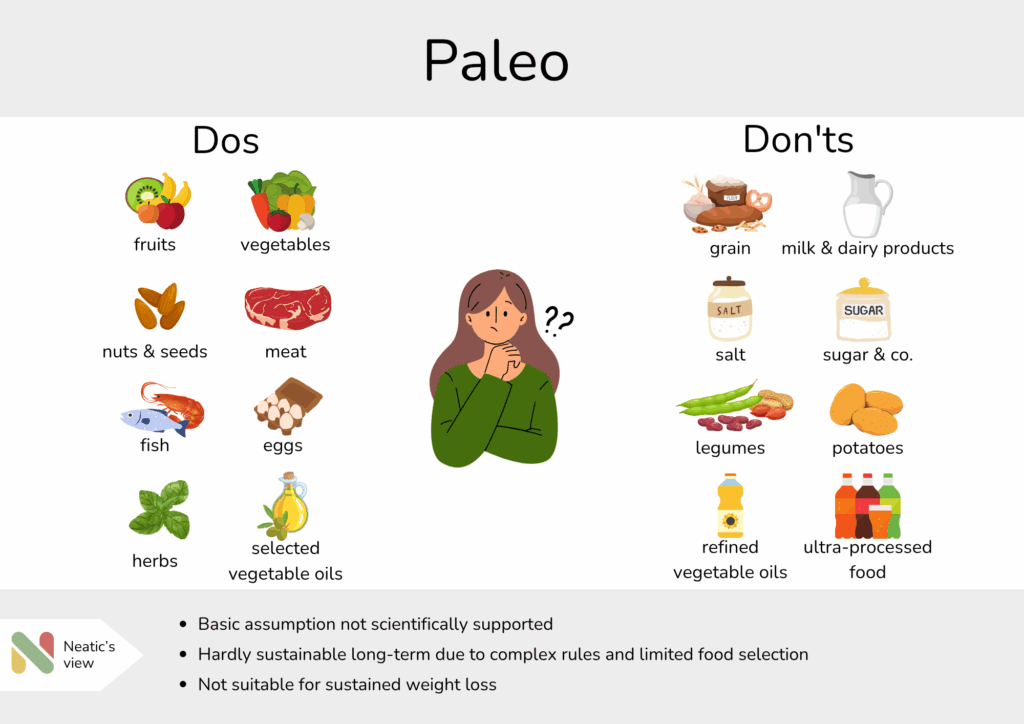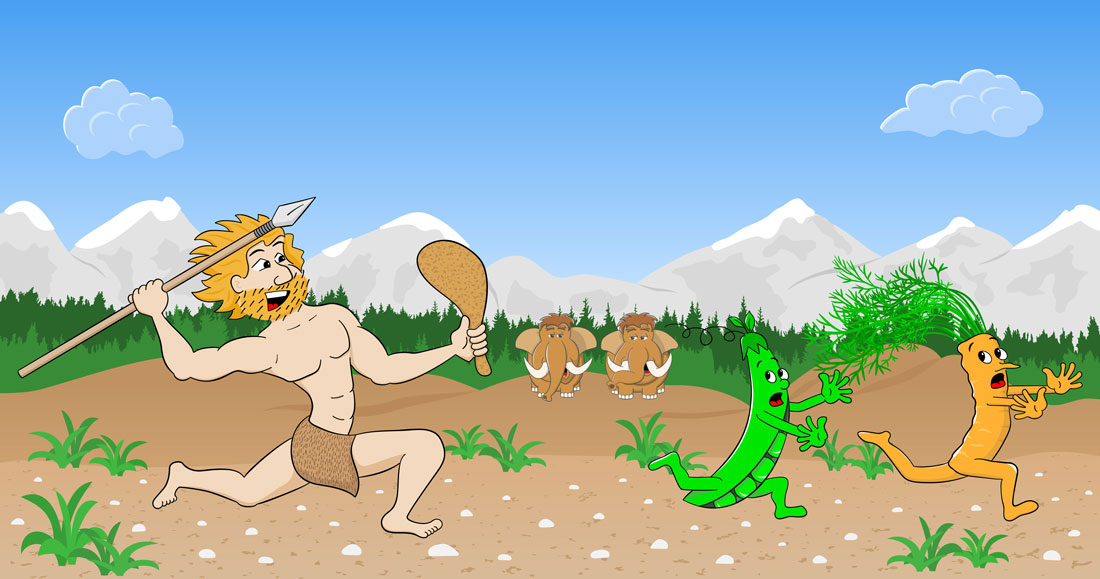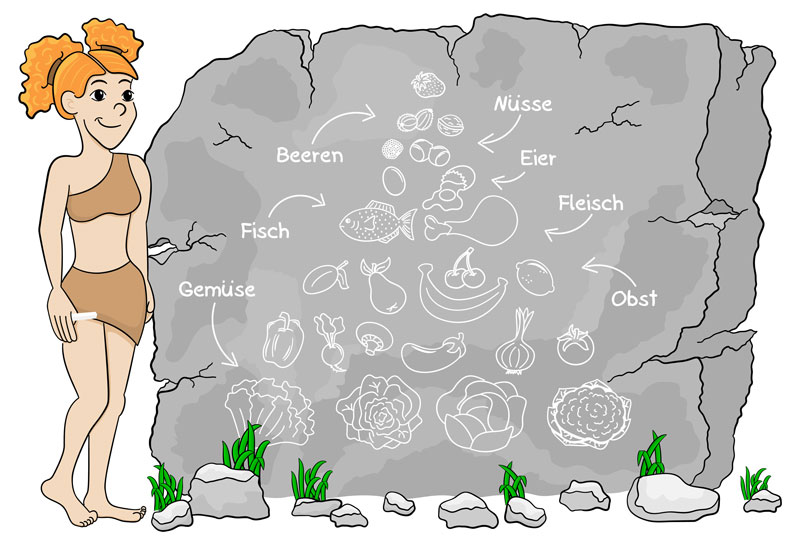
Major points:
- The Paleo diet attempts to imitate the eating habits of hunter-gatherer societies from the Paleolithic era.
- Short-term weight loss can be achieved with the Paleo diet, but not sustained in the long term.
- Neatic believes that the theory behind the Paleo diet is not scientifically sound and that the severe restrictions on food choices are neither reasonable nor sustainable in the long term.
What is the Paleo diet?
Paleo is derived from the Greek word “Paleolithic”, which means “old” and “stone”. The Paleo diet is therefore a diet based on the availability of food in the Palaeolithic period. At that time, people were hunters and gatherers.

Basic assumption
The Paleo diet is based on Charles Darwin’s theory of evolution. This states that in the course of evolution those species have prevailed that were best able to adapt to their environment and thus also to the available food. In order to ensure the continuation of the human species, the genetic makeup of humans has had to change in the process of natural selection. However, these complex genetic adaptation processes take very long periods of time. As a result, not enough time has passed from the Paleolithic era to the present day for genetic adaptation to the changes in food supply brought about by agriculture and animal husbandry.
Paleo nutrition picks up on this theory with the following hypothesis: A strongly altered food supply in combination with our Paleolithic genetic makeup leads not only to the development of obesity but also to many other diseases of civilization, such as high blood pressure or type 2 diabetes mellitus.

Food selection
In the Paleo diet, only foods that were available to people in the Paleolithic era are allowed:
- Fruits, including dried fruits without added sugar
- Vegetables
- Nuts and seeds
- Meat
- Fish
- Eggs
- Herbs
- Native plant oils
Restricted, however, are:
- Cereals and cereal products (e.g., bread, pasta, couscous, pastries)
- Milk and dairy products (e.g., yogurt, milk, cheese, butter)
- Salt
- Sweetening agents (e.g., sugar, sweeteners, sugar substitutes, syrups)
- Legumes (e.g., beans, lentils, peas, peanuts)
- Potatoes
- Refined vegetable oils and fats (e.g., canola oil, sunflower oil, margarine)
- Ultra-processed food (e.g., sausage and meat products, candy, soft drinks, fruit yogurts)
The development of the Paleo diet can be traced back to different people. Depending on which founder of the Paleo diet is chosen, the following foods are allowed in small amounts:
- Vegetable fats (e.g., olive, coconut, avocado, walnut oil)
- Coffee and tea
- Rice
- Honey and maple syrup
- Alcoholic beverages such as wine, beer and clear liquors
The Paleo diet is said to have many health benefits, such as
- Positive influence on body weight as well as insulin and fat metabolism
- Prevention of diseases of civilization such as high blood pressure, diabetes mellitus type 2, and dyslipidemia
- Improved well-being and ability to focus
- Improved sleep
- Improved digestion
Opponents of the Paleo diet contradict the statement that the genetic makeup of humans has not changed since the Paleolithic era. In addition, many critics are convinced that there was no typical Stone Age diet. Rather, it was dependent on region and climate. People have always eaten what they found in their environment.
What does science say?
There are hardly any studies on the Paleo diet, which have examined the subjects for more than one year.
In a study by Mellberg et al. (2014), the relationship of a Paleo diet and body weight was examined in 70 overweight women (BMI ≥ 27 kg/m2). The subjects were randomly divided into two groups with different diets. Over a two-year period, one group followed the Paleo diet (Paleo group), while the control group followed the Nordic Nutrition Recommendations.
The Paleo group had lost significantly more fat mass after six months compared to the control group. However, there was a rebound in fat mass in the Paleo group by the end of the study and after 24 months, the loss of fat mass was no longer significantly different between the two groups. Furthermore, in addition to fat mass, lean mass also decreased in subjects in the Paleo group. Since lean mass includes muscle mass, a decrease in lean mass is not desirable (Mellberg et al., 2014).
What does Neatic recommend concerning the Paleo diet?
An advantage of the Paleo diet is that the restriction of food choices also indirectly limits added flavors, sweeteners, and sugar. In addition, it is commendable that the consumption of fruit is not limited. As in Neatic, the craving for something sweet can therefore be satisfied by fruit.
In contrast to the Paleo diet, grains, legumes, milk, and dairy products can be eaten in Neatic without restrictions. These foods have been an integral part of our diet for centuries. Because of the severe restrictions on food choices, the Paleo diet is difficult to implement. A meal invitation at a friend’s house or eating out at a restaurant becomes a major challenge. The risk of dropping the diet is therefore much higher.
Neatic believes that the theory behind the Paleo diet is not scientifically sound and that the severe restrictions on food choices are neither reasonable nor sustainable in the long term.
The pegan diet combines the Paleo diet with a vegan diet. You can find out how it works here.
Bibliography:
Cordain, Loren (2011): The Paleo diet. Lose weight and get healthy by eating the foods you were designed to eat. Revised edition. Boston: Harvest.
Cordain, Loren (2022): The Paleo Diet®. Available online at https://thepaleodiet.com/, checked on 8/31/2022.
Gunda Backes (2018): Paleo-Diät, Glyx-Diät, Formula-Diäten – ein Überblick. DGEinfo (4), pp. 56–62.
Mellberg, Caroline; Sandberg, Susanne; Ryberg, Mats; Eriksson, Marie; Brage, Sören; Larsson, Christel; Olsson, Tommy; Lindahl, Bernt (2014): Long-term effects of a Palaeolithic-type diet in obese postmenopausal women: a 2-year randomized trial. Eur J Clin Nutr 68 (3), pp. 350–357. DOI: 10.1038/ejcn.2013.290.
